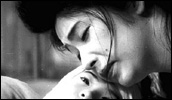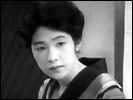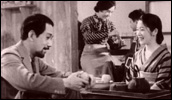Every Night Dreams
- Year
- 1933
- Original title
- Yogoto no Yume
- Japanese title
- 夜ごとの夢
- Alternative title
- Nightly Dreams
- Director
- Cast
- Running time
- 64 minutes
- Published
- 1 June 2010



by Roger Macy
Mikio Naruse's melodramas form one of the richest and most emotionally rewarding seams of all Japanese cinema, and this director is regularly cited, along with a few other contenders, as the fourth great name in Japanese film history. Screenings of his films, therefore, are always welcome. But a screening outside the exclusive system of director retrospectives is to be particularly welcomed, especially when the film is a silent, and is given the care and attention that it recently received at the Barbican in London.
Every Night Dreams, of 1933, is arguably one of the most famous Japanese films of the silent era and has had considerable attention in the literature. So I do not intend to write a lengthy treatment of the film so much as review its performance. And 'performance' it was, as it was the occasion of the premiere of a musical accompaniment by Nitin Sawhney with the London Symphony Orchestra.
The film itself is particularly agile in its subjective editing and would strike many viewers as very 'modern' in its use of swift step-wise closings-in at key dramatic moments. The subject matter is also pretty racy. The leading character, Omitsu (Kurishima), works as a bar hostess to support a child and seems to be on the look-out for any extra income going with her clientele, who are merchant seamen. A few scenes in and a good-for-nothing husband turns up, played by Tatsuo Saito - who also appears in most of Ozu's films of the thirties. Omitsu wants nothing to do with him, and Kurishima, in a role seemingly made for her, shows brilliantly the mindset of one who has been forced to struggle alone. Having forced herself to manage, she is no mood to give succour to 'the enemy' - a term she actually expresses. It's a situation that most people generally take a lifetime to climb down from, but Kurishima manages to make the turn-around for Omitsu convincing in one or two reels. It's certainly not a case of going soft - Omitsu makes the decision from her own inner strength, deciding that a child has a right to both parents. And she will need the strength for two, as her husband is an all-time loser. The story develops with superbly measured pace, with scenes of great comedy and others of much pathos, depicting the world of the great depression for those at the bottom of the heap. It's her final judgement on her husband that sticks in the mind, and hopefully you will be able to see it for yourself in a repeat performance or on DVD.
But the big-money question is - was the lavish musical setting justified? Having also seen this film with the standard piano accompaniment at the BFI, without accompaniment in Tokyo, and now with a specially composed orchestration, I'll say that it's definitely worth the price. As an active supporter of musicians, I'd hate to be the one to shoot the pianist. But at a recent screening of an Ozu silent, when the pianist was snow-bound, it was noteworthy that not one person took the offer of a refund, and several people afterwards said they actively preferred the cleaner ability to concentrate on the film. The piano, although the standard accompanying instrument in the West, was rarely if ever used in Japanese cinemas. The iron-framed piano produces a dense copious sound and it is rare to find a cinema pianist who has the confidence to twiddle his fingers through a scene. The result, for this listener, is too many notes. So how can a hundred musicians possibly be an improvement on this? Mainly because we are talking about a composed piece in which carefully organised themes are planned to be brought into selected focus. And it's also to do with the colour of orchestral instruments being a function of their reduced harmonics, in contrast to the thick, white sound of the piano.
A harmonious work of art such as this, however, is not born of raw theory. It matters not whether Sawhney or I have read Eisenstein but whether the performance worked. A diverse audience of Japanese film buffs, Sawhney fans and contemporary concert-goers thought that it did.
The fact that Sawhney has scored the music for more than 40 films obviously helps, but was no guarantee that he would succeed on his first Japanese film. But he seems to have helped himself. He has spent enough time in Japan not to need to impose his own impression of the Japanese. 'I haven't spent a lot of time thinking 'Oh, it's a Japanese film, I'll have to make the score sound Japanese.' I've spent a lot of time thinking 'How do I get into the psychology of what's going on? I was looking toward my favourite composers for inspiration, such as Bernard Hermann, because I saw certain similarities with Hitchcock in some of the scenes.' That's actually an acute observation, and may relate to influence at the time on Naruse from German expressionism - something Hitchcock actually lived through in Berlin.
In addition to a full London Symphony Orchestra, conducted by Kristjan Jãrvi, Sawhney himself played piano (sparingly) and celeste and Mieko Shimizu sang and spoke vocals. The central staging of a vocalist gave rise at the start to the possibility that we were going to have a narration from a benshi. That was not to be. We merely had a few poems in Japanese recited, without translation. Sawhney came onto the Q&A afterwards with the translations and only took the merest prompting from your Midnight Eye correspondent to recite all the translations in full. This added to the afterglow at the time, but it was the film, integrated as a scored 'sound' film, that resonated in memory.
At this point, I need to come clean on the headline. This specialist website for Japanese films always heads up reviews with their English title. But 'Every Night Dreams' - or any alternative English-language title - was nowhere to be seen on the programme. Sawhney chose to brand his show with its original-language name, Yogoto no Yume - even though his previous similar project, Franz Osten's 1929 Indian film A Throw of Dice, was billed in English and only English. So what's going on here? Sawhney seems to have moved himself upmarket and is playing by the rules of opera: it's 'La Bohème', whether you're hearing it in French or English. Either way, the ticket price has to reflect the employment of a full orchestra and lead performers. And I have to concede that Sawhney's marketing strategy worked - the stalls were full, so he succeeded in pulling in hundreds, at least, to a Japanese silent film, that would struggle to get one hundred seats sold at the BFI.
And the audience - and this critic - were well satisfied with what we got.
Afterword: apologies for the gendered, shot, pianist but I've yet to be accompanied by female fingers. In contrast, there are some wonderful chitarone players, steeped in the world of accompaniment to the performing arts, whose feminine, baroque approach could make us look at silent films afresh, who command audiences on the Southbank - and might well be within the budget of the BFI.